LITES-Based Sensitive CO2 Detection Using 2 μm Diode Laser and Self-Designed 9.5 kHz Quartz Tuning Fork
Abstract
1. Introduction
2. Experimental Setup
2.1. Selection of the CO2 Absorption Line
2.2. The Characteristics of Self-Designed Trapezoidal-Head QTF
2.3. Schematic Diagram of the Experimental Setup
3. Experimental Results and Discussion
4. Conclusions
Author Contributions
Funding
Institutional Review Board Statement
Informed Consent Statement
Data Availability Statement
Conflicts of Interest
References
- Crowley, T.J.; Berner, R.A. CO2 and climate change. Science 2001, 292, 870–872. [Google Scholar] [CrossRef] [PubMed]
- Olabi, A.G.; Abdelkareem, M.A. Renewable energy and climate change. Renew. Sustain. Energy Rev. 2022, 158, 112111. [Google Scholar] [CrossRef]
- Kawamoto, R.; Mochizuki, H.; Moriguchi, Y.; Motohashi, M.; Sakai, Y. Estimation of CO2 emissions of internal combustion engine vehicle and battery electric vehicle using LCA. Sustainability 2019, 11, 2690. [Google Scholar] [CrossRef]
- Xu, H.; Ge, Y.; Zhang, C.; Wang, Z.; Xu, B.; Zhao, H.; Huang, J.B.; Wang, G.; Liu, J.X.; Feng, Y.C.; et al. Machine learning reveals the effects of drivers on PM2.5 and CO2 based on ensemble source apportionment method. Atmos. Res. 2023, 295, 107019. [Google Scholar] [CrossRef]
- Amato, G.D.; Chong-Neto, H.J.; Ortega, O.P.M.; Ansotegui, I.; Rosario, N.; Haahtela, T. The effects of climate change on respiratory allergy and asthma induced by pollen and mold allergens. Allergy 2020, 75, 2219. [Google Scholar] [PubMed]
- Amthor, J.S. Effects of atmospheric CO2 concentration on wheat yield: Review of results from experiments using various approaches to control CO2 concentration. Field Crops Res. 2001, 73, 1–34. [Google Scholar] [CrossRef]
- Ersoez, B.; Schmitt, K.; Woellenstein, J. CO2 gas sensing with an electrolyte-gated transistor using impedance spectroscopy. Sens. Actuators B Chem. 2021, 334, 129598. [Google Scholar]
- Fu, B.T.; Gao, R.H.; Yao, N.; Zhang, H.S.; Li, C.T.; Lin, J.T.; Wang, M.; Qiao, L.L.; Cheng, Y. Soliton microcomb generation by cavity polygon modes. Opto-Electron. Adv. 2024, 7, 240061. [Google Scholar]
- Sun, B.; Patimisco, P.; Sampaolo, A.; Zifarelli, A.; Spagnolo, V.; Wu, H.; Dong, L. Light-induced thermoelastic sensor for ppb-level H2S detection in a SF6 gas matrices exploiting a mini-multi-pass cell and quartz tuning fork photodetector. Photoacoustics 2023, 33, 100553. [Google Scholar] [CrossRef]
- Wang, X.Y.; Qiu, X.K.; Liu, M.L.; Liu, F.; Li, M.M.; Xue, L.P.; Chen, B.H.; Zhang, M.R.; Xie, P. Flat soliton microcomb source. Opto-Electron. Sci. 2023, 2, 230024. [Google Scholar]
- Wang, Y.Q.; Zhang, J.H.; Zheng, Y.C.; Xu, Y.R.; Xu, J.Q.; Jiao, J.; Su, Y.; Lu, H.F.; Liang, K. Brillouin scattering spectrum for liquid detection and applications in oceanography. Opto-Electron. Adv. 2023, 6, 220016. [Google Scholar]
- Shi, L.Y.; Li, Y.J.; Li, Z. Early cancer detection by SERS spectroscopy and machine learning. Light Sci. Appl. 2023, 12, 234. [Google Scholar]
- Zhang, F.C.; Camarero, P.; Haro-González, P.; Labrador-Páez, L.; Jaque, D. Optical trapping of optical nanoparticles: Fundamentals and applications. Opto-Electron. Sci. 2023, 2, 230019. [Google Scholar]
- Shao, M.R.; Ji, C.; Tan, J.B.; Du, B.Q.; Zhao, X.F.; Yu, J.; Man, B.Y.; Xu, K.C.; Zhang, C.; Li, Z. Ferroelectrically modulate the Fermi level of graphene oxide to enhance SERS response. Opto-Electron. Adv. 2023, 6, 230094. [Google Scholar]
- Russo, S.D.; Pelini, J.; Garcia, I.L.; Canino, M.C.; Roncaglia, A.; Pastor, P.C.; Galli, I.; De Natale, P.; Borri, S.; de Cumis, M.S. Dual-tube MEMS-based spectrophone for sub-ppb mid-IR photoacoustic gas detection. Photoacoustics 2024, 40, 100644. [Google Scholar]
- Rossi, J.; Vainio, M. Calibration-free infrared absorption spectroscopy using cantilever-enhanced photoacoustic detection of the optical power. Photoacoustics 2024, 40, 100655. [Google Scholar] [PubMed]
- Qiao, S.; He, Y.; Sun, H.; Patimisco, P.; Sampaolo, A.; Spagnolo, V.; Ma, Y. Ultra-highly sensitive dual gases detection based on photoacoustic spectroscopy by exploiting a long-wave; high-power; wide-tunable; single-longitudinal-mode solid-state laser. Light Sci. Appl. 2024, 13, 100. [Google Scholar]
- Fu, B.; Zhang, C.; Lyu, W.; Sun, J.; Shang, C.; Cheng, Y.; Xu, L. Recent progress on laser absorption spectroscopy for determination of gaseous chemical species. Appl. Spectrosc. Rev. 2022, 57, 112–152. [Google Scholar]
- Wang, K.; Guo, R.; Zhou, Y.; Jiao, L.; Dong, D. Detection of NH3 in poultry housing based on tunable diode laser absorption spectroscopy combined with a micro circular absorption cell. Front. Phys. 2022, 10, 1051719. [Google Scholar]
- Chen, Y.J.; Ma, H.X.; Qiao, S.D.; He, Y.; Fang, C.; Li, Q.; Zhou, S.; Ma, Y.F. Rapid ppb-Level methane detection based on quartz-enhanced photoacoustic spectroscopy. Anal. Chem. 2025. [Google Scholar] [CrossRef]
- Li, T.G.; Zhao, P.C.; Wang, P.; Krishnaiah, K.V.; Jin, W.; Zhang, A.P. Miniature optical fiber photoacoustic spectroscopy gas sensor based on a 3D micro-printed planar-spiral spring optomechanical resonator. Photoacoustics 2024, 40, 100657. [Google Scholar] [CrossRef]
- Ma, H.X.; Chen, Y.J.; Qiao, S.D.; He, Y.; Ma, Y.F. A high sensitive methane QEPAS sensor based on self-designed trapezoidal-head quartz tuning fork and high power diode laser. Photoacoustics 2025, 42, 100683. [Google Scholar] [PubMed]
- Hou, J.F.; Liu, X.N.; Sun, H.Y.; He, Y.; Qiao, S.D.; Zhao, W.J.; Zhou, S.; Ma, Y.F. Dual-component gas sensor based on light-induced thermoelastic spectroscopy and deep learning. Anal. Chem. 2025, 97, 5200–5208. [Google Scholar] [CrossRef] [PubMed]
- Zhang, C.; Qiao, S.D.; He, Y.; Liu, C.M.; Ma, Y.F. Multi-resonator T-type photoacoustic cell based photoacoustic spectroscopy gas sensor for simultaneous measurement C2H2. CH4 and CO2. Sens. Actuator B-Chem. 2025, 427, 137168. [Google Scholar]
- Kosterev, A.A.; Bakhirkin, Y.A.; Curl, R.F.; Tittel, F.K. Quartz-enhanced photoacoustic spectroscopy. Opt. Lett. 2002, 27, 1902. [Google Scholar]
- Zifarelli, A.; Negro, G.; Mongelli, L.A.; Sampaolo, A.; Ranieri, E.; Dong, L.; Wu, H.; Patimisco, P.; Gonnella, G.; Spagnolo, V. Effect of gas turbulence in quartz-enhanced photoacoustic spectroscopy: A comprehensive flow field analysis. Photoacoustics 2024, 38, 100625. [Google Scholar]
- Wang, L.H.; Lv, H.H.; Zhao, Y.H.; Wang, C.L.; Luo, H.J.; Lin, H.Y.; Xie, J.B.; Zhu, W.G.; Zhong, Y.C.; Liu, B.; et al. Sub-ppb level HCN photoacoustic sensor employing dual-tube resonator enhanced clamp-type tuning fork and U-net neural network noise filter. Photoacoustics 2024, 38, 100629. [Google Scholar]
- Feng, C.; Shen, X.; Li, B.; Liu, X.; Jing, Y.; Huang, Q.; Patimisco, P.; Spagnolo, V.; Dong, L.; Wu, H. Carbon monoxide impurities in hydrogen detected with resonant photoacoustic cell using a mid-IR laser source. Photoacoustics 2024, 36, 100585. [Google Scholar] [CrossRef]
- Ma, Y.; He, Y.; Tong, Y.; Yu, X.; Tittel, F.K. Quartz-tuning-fork enhanced photothermal spectroscopy for ultra-high sensitive trace gas detection. Opt. Express 2018, 26, 32103–32110. [Google Scholar]
- Liu, Y.H.; Qiao, S.D.; Fang, C.; He, Y.; Sun, H.Y.; Liu, J.; Ma, Y.F. A highly sensitive LITES sensor based on a multi-pass cell with dense spot pattern and a novel quartz tuning fork with low frequency. Opto-Electron. Adv. 2024, 7, 230230. [Google Scholar]
- Zifarelli, A.; Sampaolo, A.; Patimisco, P.; Giglio, M.; Gonzalez, M.; Wu, H.P.; Dong, L.; Spagnolo, V. Methane and ethane detection from natural gas level down to trace concentrations using a compact mid-IR LITES sensor based on univariate calibration. Photoacoustics 2023, 29, 100448. [Google Scholar] [CrossRef] [PubMed]
- Zhao, X.Y.; Li, C.X.; Qi, H.C.; Huang, J.Y.; Xu, Y.F.; Wang, Z.Z.; Han, X.; Guo, M.; Chen, K. Integrated near-infrared fiber-optic photoacoustic sensing demodulator for ultra-high sensitivity gas detection. Photoacoustics 2023, 33, 100560. [Google Scholar] [CrossRef]
- He, Y.; Wang, Y.; Qiao, S.; Duan, X.; Qi, H.; Ma, Y. Hydrogen-enhanced light-induced thermoelastic spectroscopy sensing. Photonics Res. 2025, 13, 194–200. [Google Scholar] [CrossRef]
- Ma, Y.F.; Liang, T.T.; Qiao, S.D.; Liu, X.N.; Lang, Z.T. Highly sensitive and fast hydrogen detection based on light-induced thermoelastic spectroscopy. Ultrafast Sci. 2023, 3, 0024. [Google Scholar] [CrossRef]
- Sun, H.Y.; He, Y.; Qiao, S.D.; Liu, Y.H.; Ma, Y.F. Highly sensitive and real-simultaneous CH4/C2H2 dual-gas LITES sensor based on Lissajous pattern multi-pass cell. Opto-Electron. Sci. 2024, 3, 240013. [Google Scholar] [CrossRef]
- Jiang, S.L.; Chen, F.F.; Zhao, Y.; Gao, S.F.; Wang, Y.Y.; Ho, H.L.; Jin, W. Broadband all-fiber optical phase modulator based on photo-thermal effect in a gas-filled hollow-core fiber. Opto-Electron. Adv. 2023, 6, 220085. [Google Scholar] [CrossRef]
- Ma, Y.F.; Liu, Y.H.; He, Y.; Qiao, S.D.; Sun, H.Y. Design of multipass cell with dense spot patterns and its performance in a light-induced thermoelastic spectroscopy-based methane sensor. Light Adv. Manuf. 2025, 6, 1. [Google Scholar] [CrossRef]
- Wang, J.; Wu, H.; Liu, X.; Wang, G.; Wang, Y.; Feng, C.; Cui, R.; Gong, Z.; Dong, L. Cantilever-enhanced dual-comb photoacoustic spectroscopy. Photoacoustics 2024, 38, 100605. [Google Scholar] [CrossRef]
- Lang, Z.T.; Qiao, S.D.; Ma, Y.F. Fabry-Perot-based phase demodulation of heterodyne light-induced thermoelastic spectroscopy. Light Adv. Manuf. 2023, 4, 23. [Google Scholar] [CrossRef]
- Lou, C.; Yang, X.; Li, X.; Chen, H.; Chang, C.; Liu, X. Graphene-enhanced quartz tuning fork for laser-induced thermoelastic spectroscopy. IEEE Sens. J. 2021, 21, 9819. [Google Scholar] [CrossRef]
- Wang, R.Q.; Qiao, S.D.; He, Y.; Ma, Y.F. Highly sensitive laser spectroscopy sensing based on a novel four-prong quartz tuning fork. Opto-Electron. Adv. 2025, 8, 240275. [Google Scholar] [CrossRef]
- Sun, H.Y.; He, Y.; Qiao, S.D.; Zhang, C.; Ma, Y.F. Highly sensitive H2S-LITES sensor with 80 m fiber-coupled multi-pass cell based on optical path multiplexing technology. Photoacoustics 2025, 42, 100699. [Google Scholar] [CrossRef]
- Mei, H.; Wang, G.; Xu, Y.; He, H.; Yao, J.; He, S. Simultaneous measurement of methane, propane and isobutane using a compact mid-infrared photoacoustic spectrophone. Photoacoustics 2024, 39, 100635. [Google Scholar] [CrossRef] [PubMed]
- Ma, Y.F.; Qiao, S.D.; Wang, R.Q.; He, Y.; Fang, C.; Liang, T.T. A novel tapered quartz tuning fork-based laser spectroscopy sensing. Appl. Phys. Rev. 2024, 11, 041412. [Google Scholar] [CrossRef]
- Luo, H.J.; Yang, Z.F.; Zhuang, R.B.; Lv, H.H.; Wang, C.L.; Lin, H.Y.; Zhang, D.; Zhu, W.G.; Zhong, Y.C.; Cao, Y.; et al. Ppbv-level mid-infrared photoacoustic sensor for mouth alcohol test after consuming lychee fruits. Photoacoustics 2023, 33, 100559. [Google Scholar] [CrossRef] [PubMed]
- Ma, H.X.; Qiao, S.D.; He, Y.; Zhang, C.; Ma, Y.F. Load capacitance matching for resonant frequency adjusting-based multi-quartz tuning fork-enhanced laser spectroscopic sensing. Opt. Express 2025, 33, 9423–9433. [Google Scholar] [CrossRef]
- Bi, S.Q.; Zhang, X.R.; Zhang, Z.H.; Liu, X.; Qin, L.; Shi, J.Q.; Zhao, Y.Y.; Wang, Z.L. A light-induced thermoelastic spectroscopy using surface mounted device quartz tuning fork. Photoacoustics 2025, 42, 100686. [Google Scholar] [CrossRef]
- Li, S.Z.; Yuan, Y.P.; Shang, Z.J.; Yin, X.K.; Sampaolo, A.; Patimisco, P.; Spagnolo, V.; Dong, L.; Wu, H.P. Ppb-level NH3 photoacoustic sensor combining a hammer-shaped tuning fork and a 9.55 μm quantum cascade laser. Photoacoustics 2023, 33, 100557. [Google Scholar] [CrossRef] [PubMed]


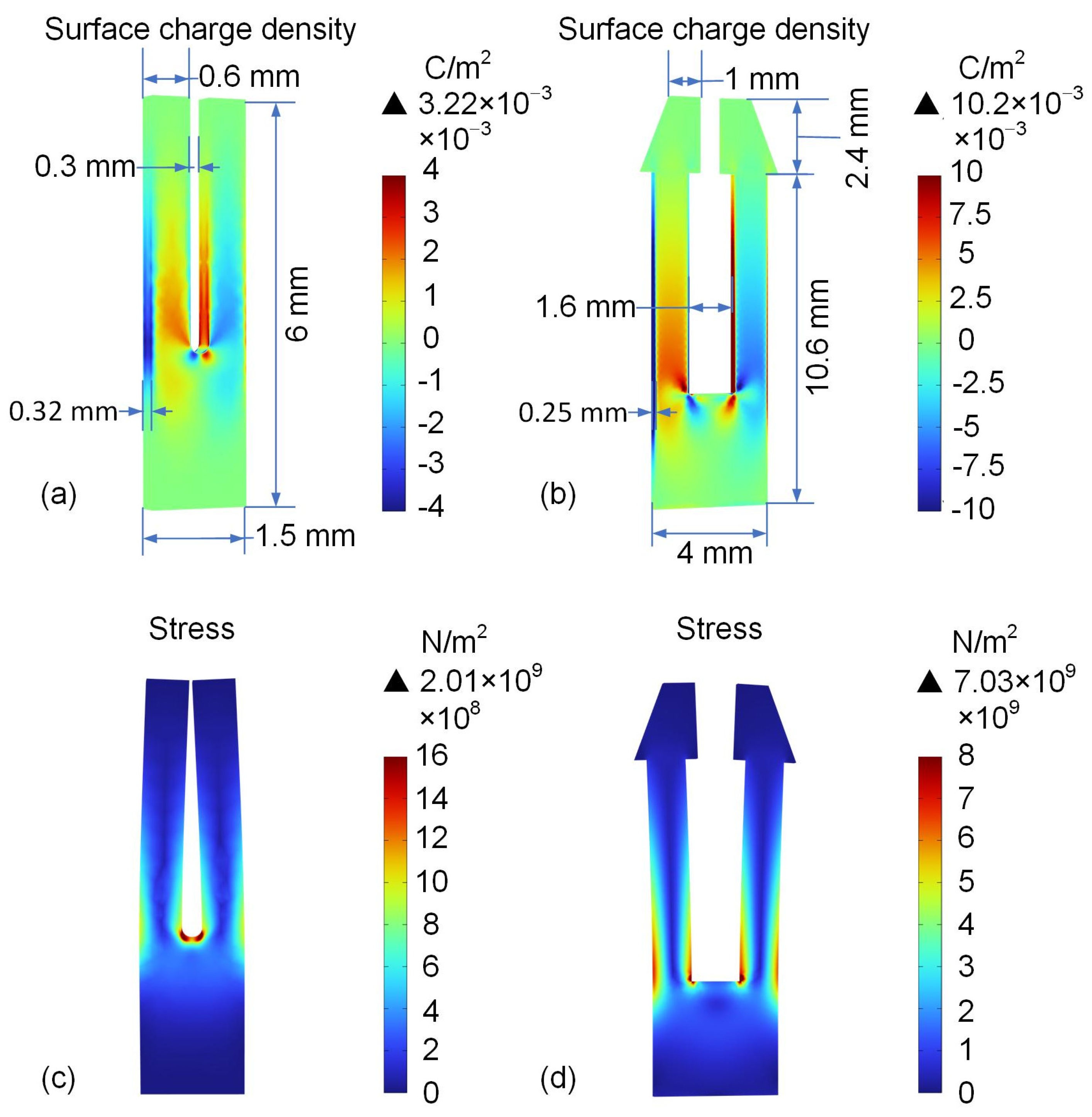

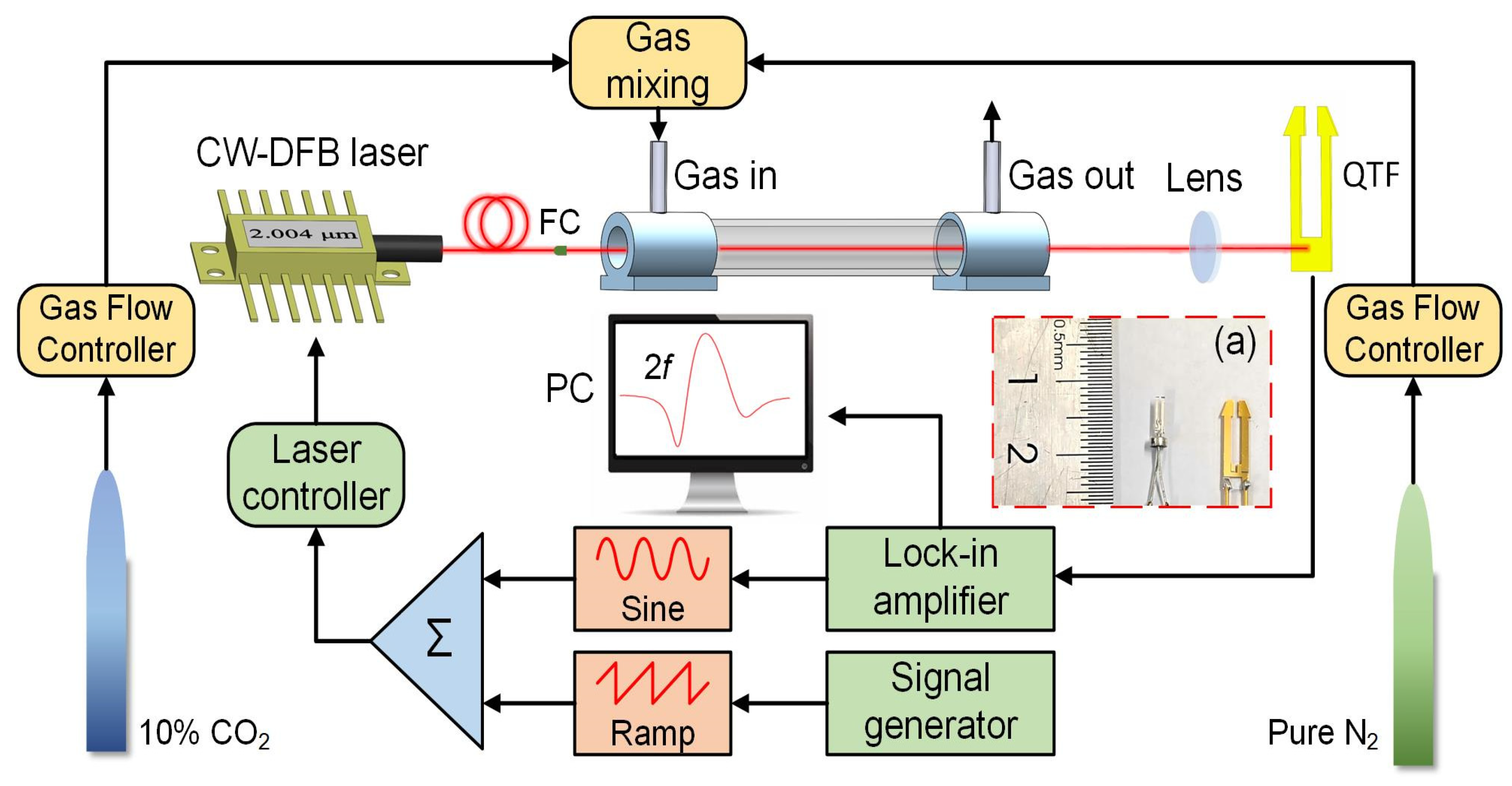
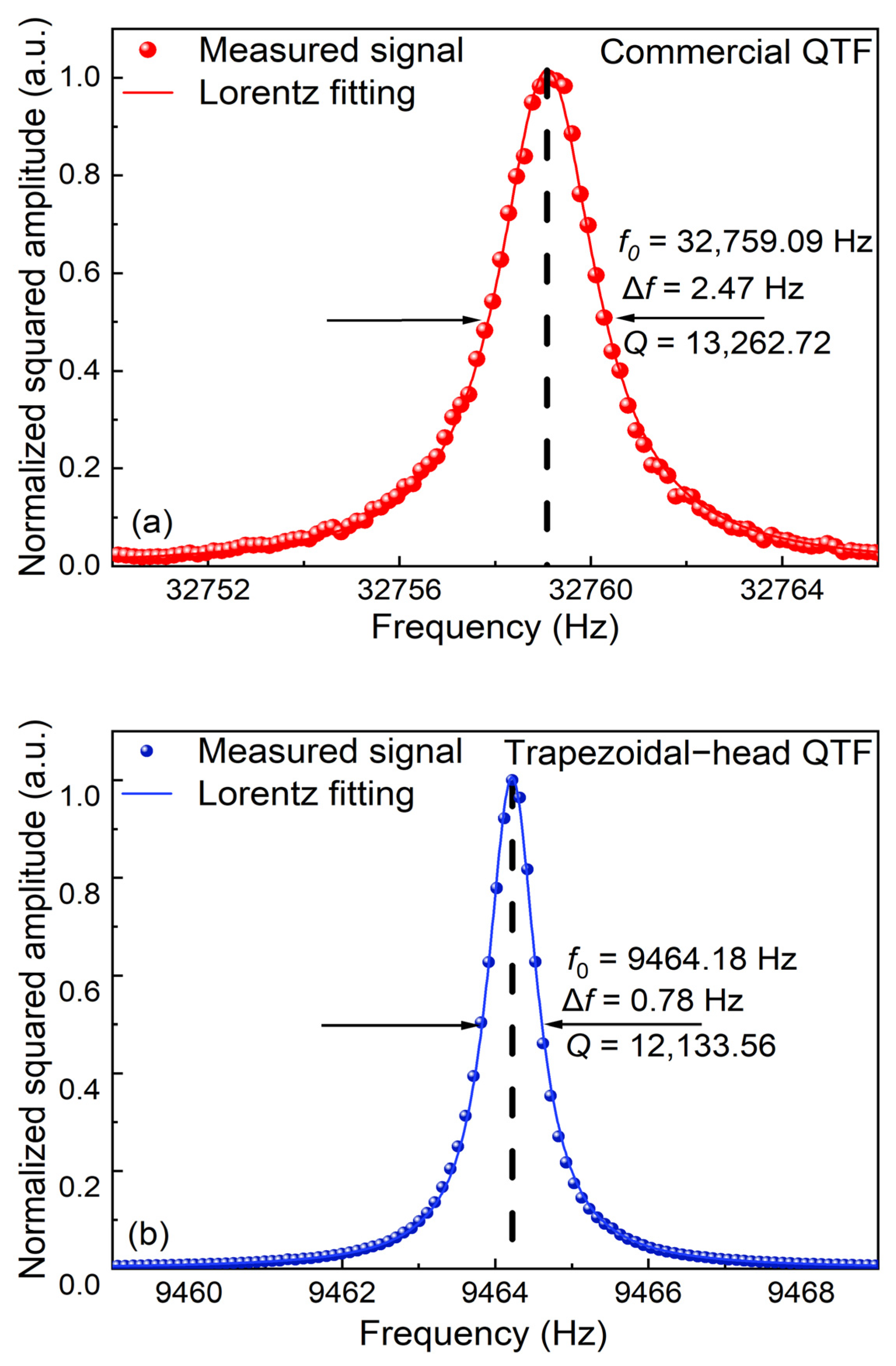

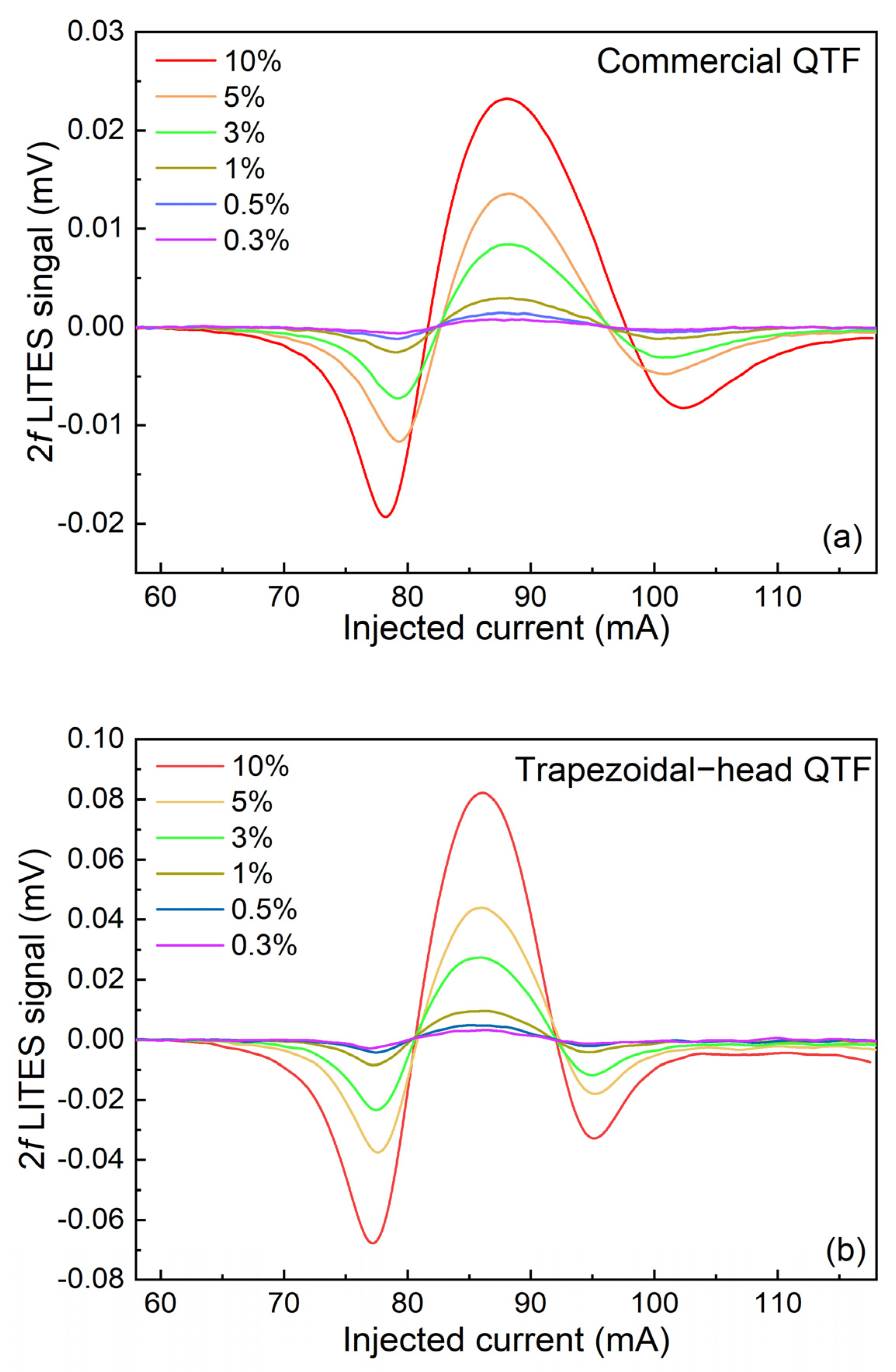

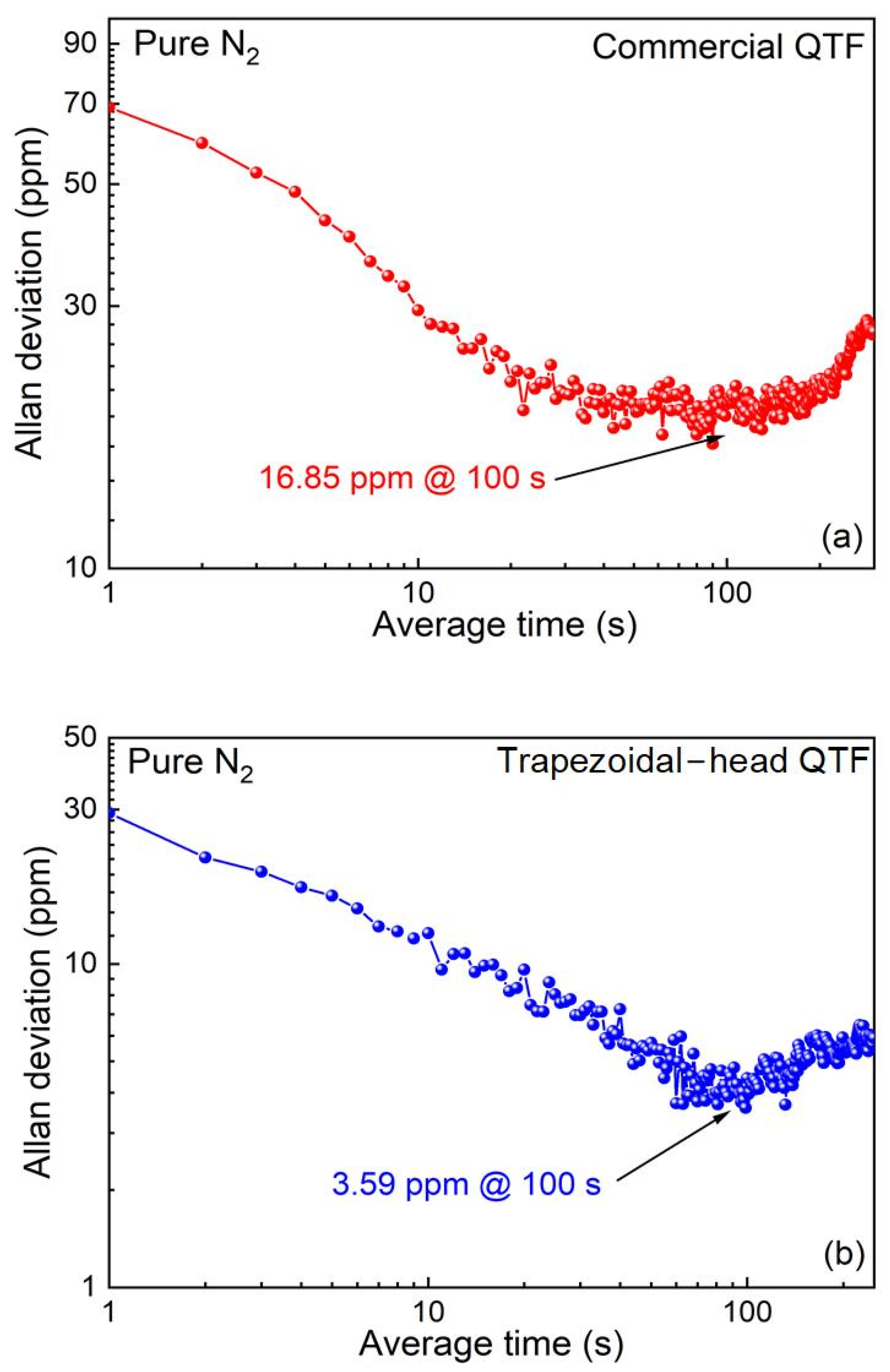
Disclaimer/Publisher’s Note: The statements, opinions and data contained in all publications are solely those of the individual author(s) and contributor(s) and not of MDPI and/or the editor(s). MDPI and/or the editor(s) disclaim responsibility for any injury to people or property resulting from any ideas, methods, instructions or products referred to in the content. |
© 2025 by the authors. Licensee MDPI, Basel, Switzerland. This article is an open access article distributed under the terms and conditions of the Creative Commons Attribution (CC BY) license (https://creativecommons.org/licenses/by/4.0/).
Share and Cite
Mu, J.; Hou, J.; Qiu, S.; Qiao, S.; He, Y.; Ma, Y. LITES-Based Sensitive CO2 Detection Using 2 μm Diode Laser and Self-Designed 9.5 kHz Quartz Tuning Fork. Sensors 2025, 25, 2099. https://doi.org/10.3390/s25072099
Mu J, Hou J, Qiu S, Qiao S, He Y, Ma Y. LITES-Based Sensitive CO2 Detection Using 2 μm Diode Laser and Self-Designed 9.5 kHz Quartz Tuning Fork. Sensors. 2025; 25(7):2099. https://doi.org/10.3390/s25072099
Chicago/Turabian StyleMu, Junjie, Jinfeng Hou, Shaoqi Qiu, Shunda Qiao, Ying He, and Yufei Ma. 2025. "LITES-Based Sensitive CO2 Detection Using 2 μm Diode Laser and Self-Designed 9.5 kHz Quartz Tuning Fork" Sensors 25, no. 7: 2099. https://doi.org/10.3390/s25072099
APA StyleMu, J., Hou, J., Qiu, S., Qiao, S., He, Y., & Ma, Y. (2025). LITES-Based Sensitive CO2 Detection Using 2 μm Diode Laser and Self-Designed 9.5 kHz Quartz Tuning Fork. Sensors, 25(7), 2099. https://doi.org/10.3390/s25072099










